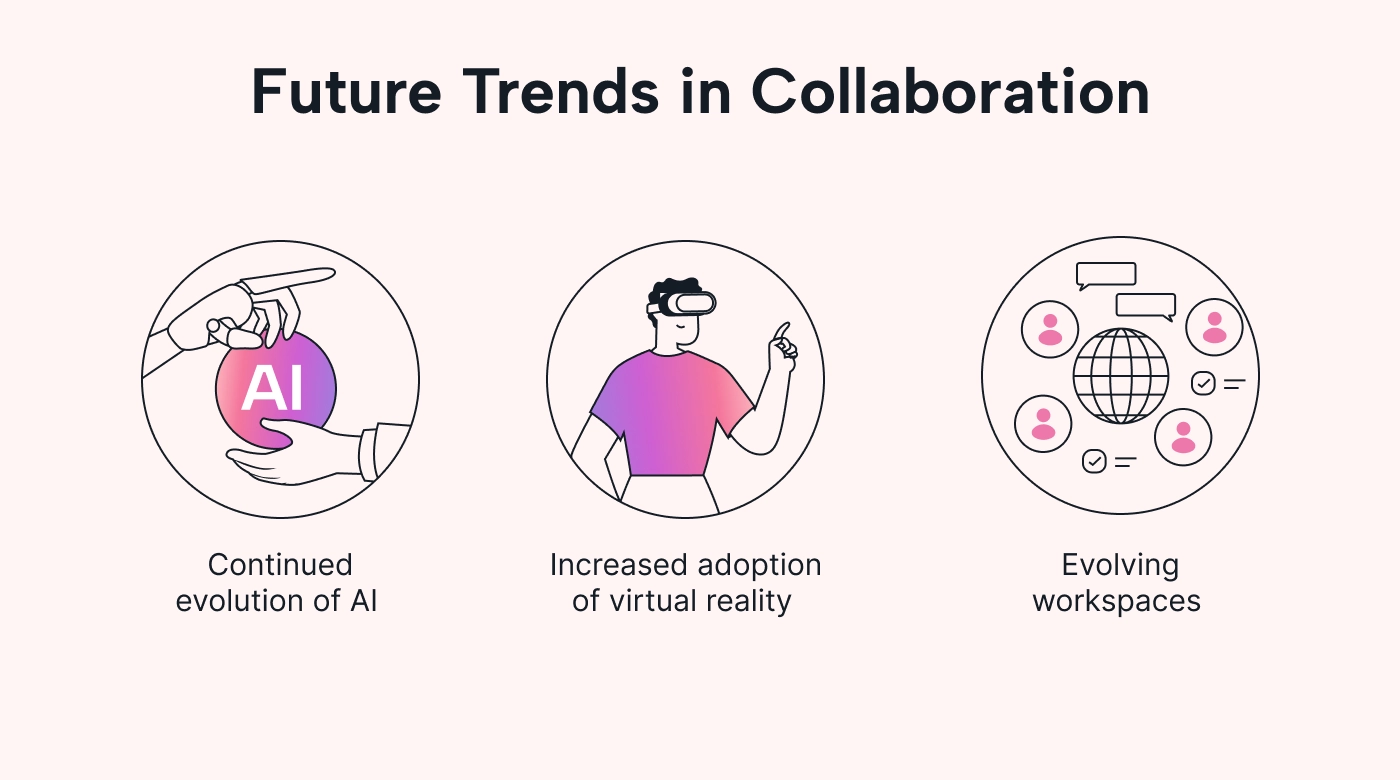Most of the worthwhile things humans have accomplished wouldn’t be possible without effective collaboration. Whether we’re landing astronauts on the moon or creating the internet, we’re most productive when we work together.
While collaboration is useful, it’s certainly not effortless.
If you’re looking for strategies to jumpstart your team’s collaborative efforts, look no further than this list. We offer useful tips for effective teamwork and discuss where future workplace trends are taking us.
What is effective collaboration?
Effective collaboration happens when team members communicate openly and work together seamlessly.
Seems straightforward. But while we all collaborate daily, that doesn’t mean we do it well.
A 2022 report found that poor cross-team collaboration is the number one challenge to project management success.
Collaborators often suffer from:
- A lack of clear team goals
- Confusion over roles and responsibilities
- Miscommunication
That’s why effective team collaboration is so valuable. The teams that do it well get results.
17 strategies for effective collaboration
Let’s jump right into our list of collaboration strategies. Each one is unique and full of action-packed tips to get your team in sync.
1. Host diverse thinking workshops
Healthy collaboration thrives in a diverse culture. Hosting workshops is a great way to cultivate multiple ways of thinking.
 |
Put together collaborative teams of employees from different backgrounds, departments, and skill sets. You can start with an icebreaker, and then launch into a problem-solving exercise that requires novel thinking.
For example, ask your team members to reimagine an existing product for a new market. They’d have to research, put together a pitch, and present the pitch to the rest of the group.
The goal is for each team to use all their resources.
2. Have clear but flexible roles
It’s important to map out each team member’s core responsibilities, as this brings clarity and accountability to the workplace.
But rigid roles can also make teamwork grow stale. So, incorporate a “flex day” each month where team members can swap tasks or focus on different projects. This encourages innovation and team growth.
You can also allow team members to nominate themselves for new roles in upcoming projects. To be sure you’re making decisions as a team, you could follow these nominations with an anonymous vote.
3. Establish feedback forums
Constructive feedback is an integral part of team growth. Create a dedicated time and space where team members can get feedback from their coworkers.
Designate a facilitator during this time. Pair up individuals for one-on-one feedback or break out into groups. Set a theme or topic for each session, such as product design feedback or customer service improvements.
Anonymous feedback tools, like Slido or Mentimeter, can collect real-time feedback during these sessions.
Be sure to create action plans based on the feedback given, too.
4. Have fewer but better meetings
Meetings aren’t always popular, but that’s often because organizations have too many of them and for too long at a time. Tim Cook, CEO of Apple, is credited with saying, “The longer the meeting, the less is accomplished.”
You could avoid an excessive number of meetings with a zero-meeting starting point each quarter. Here, you start without scheduled meetings and only add them when necessary.
Here are some more tips:
- Use asynchronous tools for simple updates
- Set a limit on the number of meetings you hold per week
- Have certain days of the week be meeting-free — reserved for deep focus
5. Use a shared calendar
Keep every team member on the same page by introducing a shared calendar system. Motion seamlessly integrates with popular calendars like iCloud, Google Calendar, and Microsoft Teams. Team members can also block out chunks of time for focusing on Motion.
Interactive calendars can automatically adjust to local time for teams across multiple time zones. They also track deadlines and important reminders so that individuals don’t lose sight of their priorities.
6. Implement programs for idea incubation
One way to jumpstart collaboration is to incubate new ideas. Host “idea marathons” where teams sprint to develop products or solutions and pitch them to the group.
Provide resources, mentorship, and support to bring these ideas to life. You can also let teams pitch their ideas to senior executives to improve their presentation skills.
Offer a month-long window where employees can submit ideas. Then, the team leaders can vote on the best ideas and offer tools and guidance to help everyone implement the winning ideas.
7. Hold team bonding events
Successful collaboration isn’t just about productivity. It’s also about forming the relationships that make that productivity possible.
Consider the following:
- Holding annual retreats
- Encouraging team-building games
- Promoting casual conversations
Teams can use informal communication channels to connect. Messaging apps and video calling tools are the most commonly used options.
 |
You can also set up comfortable lounge areas for coffee and conversation. Or, if your team is remote, set up a “virtual watercooler” area where teams can chat about their lives and non-work-related topics.
Lastly, carve a few minutes out of every meeting to have quizzes where team members guess personal facts about each other.
8. Use storytelling to share lessons learned
Another great way to transform meetings is by incorporating the power of storytelling. Set aside time for team members to share personal stories on how they overcame certain challenges.
These stories should encourage the team to see learning as a journey so they can reflect on their experiences going forward. It will also normalize failures and give the team a broader perspective on any struggles they might be facing.
You can make this into a challenge where the staff submits their stories, and the company recognizes a few of them. Or create a story archive where team anecdotes can be kept and categorized by themes or lessons. That way, you have a searchable resource where team members can learn from each other and seek specific guidance.
9. Adopt tools for asynchronous brainstorming
Individuals need to be able to collaborate on their own timeframe. Luckily, there’s never been more tools available to facilitate asynchronous teamwork.
Examples of such tools include the following:
- Project management platforms
- Collaborative documents
- File-sharing apps
For example, AI-powered whiteboards allow team members to contribute ideas and feedback when they choose to. Then, as the team generates ideas, AI automatically categorizes them or offers suggestions based on the information shared.
10. Cross-train team members to help them build empathy
Cross-train your staff so that different roles and departments can better empathize with each other.
 |
This mutual understanding does the following:
- Breaks down silos
- Improves communication
- Allows for better knowledge sharing
You can also frame this training as a mini-internship. For a short time, team members can gain in-depth experience in new areas. Another option is to host skill exchange sessions.
However you do it, encourage your staff to maintain journals while they’re training. That will help solidify the insights they gain from it.
11. Incorporate social responsibility projects
Engaging teams in projects that contribute to social good boosts morale and collaboration in the workplace. A report by Boston College's Carroll School of Management found that those who volunteer as employees are more engaged than those who don't.
You can use your staff’s talents to educate local kids or community members on important skills, such as coding or budgeting. Or you can match team skills to local nonprofits’ needs. A third option is to host sustainability challenges in-house, where the team tries to meet a waste or energy use reduction goal, for instance.
12. Pair each team member with a mentor
Develop a pairing system that matches mentors and mentees based on skill gaps and career aspirations.
Be thoughtful in providing a mutually beneficial learning journey for these individuals. You can even make it fun by setting it up as a mentorship version of speed dating. Potential collaborators meet in rapid succession and then pair up based on chemistry.
This system could also take the form of a group, where one mentor helps a small group of staff.
Give younger staff a chance to reverse-mentor — sharing their understanding of new tech and trends, for example.
13. Facilitate customer immersion experiences
Immersion in the preferences and needs of the customer can open new pathways for innovation and collaboration.
That understanding can come from:
- User research sessions
- Customer support shadowing
- Field visits
When team members spend time experiencing the customer journey from start to finish, they can better understand — and improve on — the organization’s products and services. For example, they might realize that the company’s website isn’t intuitive enough. With this knowledge, they can work together to improve the customer experience.
14. Hold vision-building workshops
A company’s shared vision and objectives can change over time. Teams that intentionally craft this vision as they go are more likely to be working toward worthy priorities.
 |
Organize workshops to refine the company’s direction, letting different teams come up with their own views to share. At the end, host a discussion that brings together the best of the elements presented.
Vision board apps can be useful for teams to collaboratively create and edit. Or you can have staff write letters from the future, describing what they’ve achieved and how the team’s vision led them there.
15. Let your team make decisions
Empower your team by involving them in the decision-making process. Ask for their input in small projects where they might have full decision-making authority or even loftier discussions about company strategy.
Another idea is to have a rotation going for decision-making roles, such as for committees or heading up employee-led initiatives.
Here are a few more tips to empower your team to make decisions:
- Offer rewards for proactive decision-making
- Run through decision-making scenarios as a team
- Offer support and resources to those given decision-making roles
16. Develop a collaboration playbook
Create a digital playbook that contains the following:
- Best practices
- Tools
- Strategies for effective collaboration
This playbook would help new hires onboard quickly and begin collaborating sooner. It could also serve as a go-to resource for conflict resolution strategies.
By clarifying communication channels and offering detailed guidance on how to manage projects, the company can facilitate long-term collaboration.
17. Model a work-life balance
Poor work-life balance isn’t just bad for individuals. It affects the whole team.
Encourage healthy work habits to maintain team well-being and productivity. Modeling this balance is the best way to incorporate it into your workplace culture.
 |
Lead by example through “unplugged hours,” where the team collectively disconnects from work.
Also, offer regular workshops on:
- Time management
- Digital detoxing
- Mindfulness
Future trends in workplace collaboration
As the modern working world evolves, our approach to collaboration in the workplace must shift with it. Here are a few of the main trends unfolding now:
 |
Continued evolution of AI
AI will continue to automate simple tasks, which will free up team members to collaborate on higher-level strategy and decision-making.
AI tools will analyze how successful teams work together and offer suggestions on how to better collaborate. Sophisticated tools, such as Motion, will optimize schedules automatically and organize complex projects into clear workflows.
Data-driven insights will reduce the time spent on trial and error. Staff can make informed decisions and act more quickly.
Increased adoption of virtual reality
VR and AR allow for realistic simulations when training, making team building more immersive and effective. They can also create virtual workspaces that mimic real life, helping remote teams collaborate as if they were in the same room. So, it’s no surprise that these technologies are going to be used more for training, meetings, and making remote work more interactive.
Evolving workspaces
Workplaces will continue moving toward flexible setups.
Examples of these setups include the following:
- Co-working spaces
- Hybrid models
- Fully remote teams
This will continue to shape how innovative teams communicate and work together. Advanced project management and communication tools will be required, as a result, to keep everyone on the same page.
Power your team’s collaboration with Motion
Few aspects of an organization are as important as how its teams collaborate. You now have plenty of actionable strategies to implement today and start fueling more effective collaboration.
Just make sure you have the right software to get you there.
Motion is an advanced project management app that drives productivity across an entire team. With it, you can leave manual planning and obsessing over deadlines behind. Your team is free to execute tasks and projects with precision.
Try Motion for free today!

Jared Posey is a business, SaaS, and productivity freelance writer with a passion for conencting readers with high-quality content. When he's not polishing up a sentence or conducting SERP research, you'll find him making his kids laugh and his wife shake her head.




